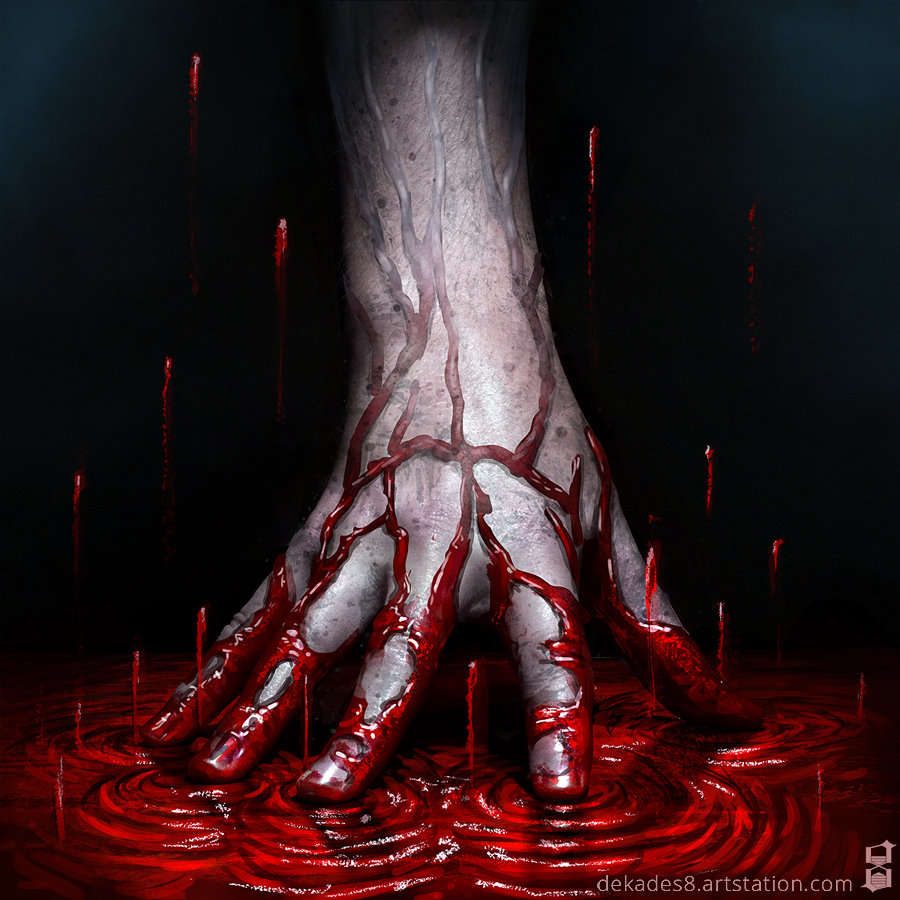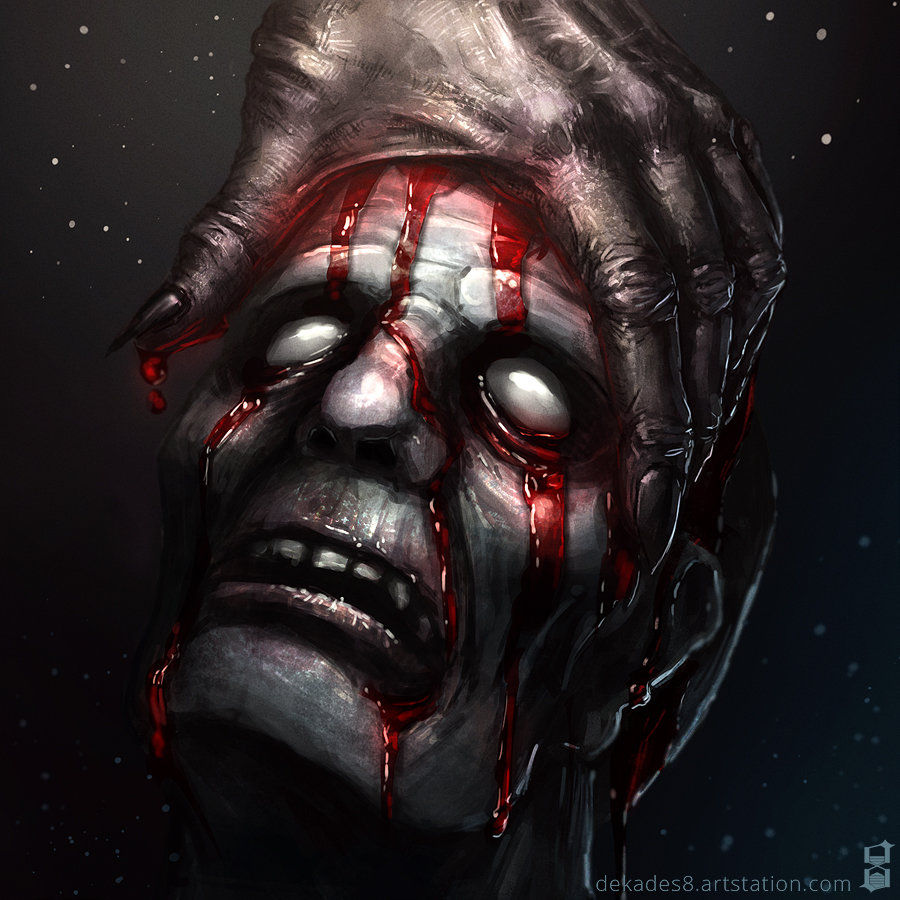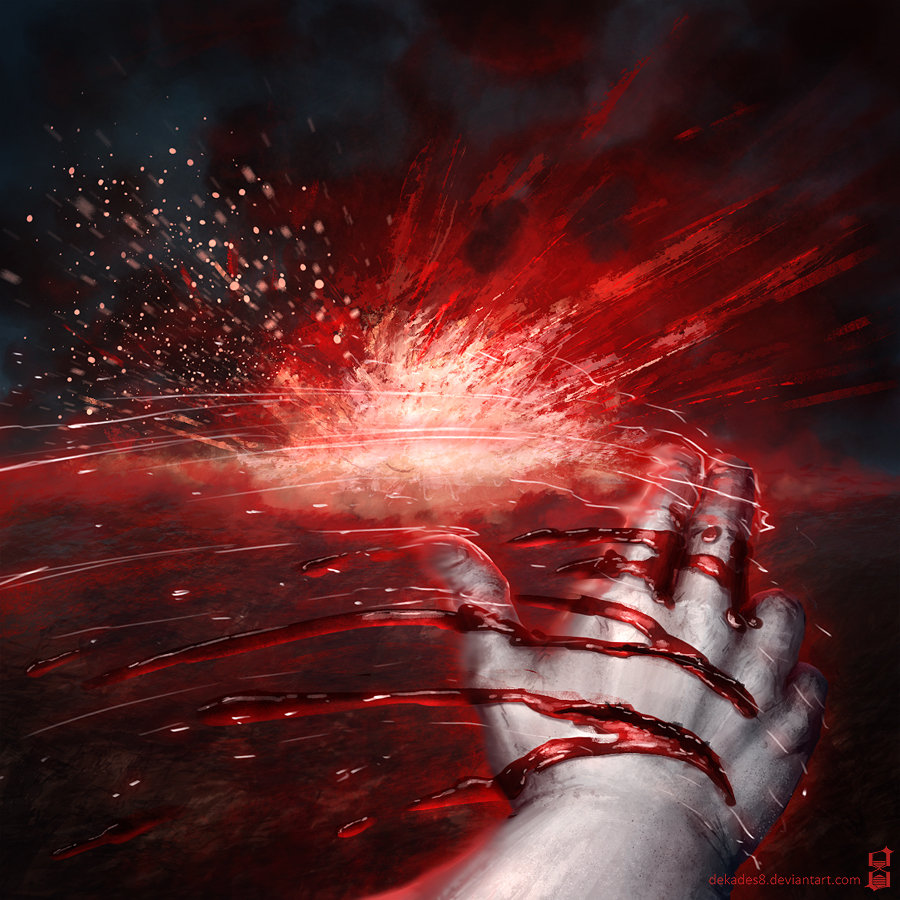


Hematurge
what is a hematurge?
It's in the Blood
what does a hematurge do?
Essence of Life
how do they do it?
Making a Hematurge
how can one become a hematurge?
Quick Build
quickest way to become a hematurge
Hematurge Class Table
| Level | Proficiency Bonus |
Features | Vitality Die |
Cantrips Known |
1st | 2nd | 3rd | 4th | 5th | Bloodletting Level |
|---|---|---|---|---|---|---|---|---|---|---|
| 1st | +2 | Blood Rite feature, Vitality | 1d4 | — | — | — | — | — | — | — |
| 2nd | +2 | Bloodletting, Spellcasting | 1d4 | 2 | 2 | — | — | — | — | 1st |
| 3rd | +2 | Fighting Style | 2d4 | 2 | 3 | — | — | — | — | 2nd |
| 4th | +2 | Ability Score Improvement | 2d4 | 3 | 3 | — | — | — | — | 2nd |
| 5th | +3 | ─ | 3d4 | 3 | 4 | 2 | — | — | — | 3rd |
| 6th | +3 | Blood Rite feature | 3d4 | 3 | 4 | 2 | — | — | — | 3rd |
| 7th | +3 | Bloodletting Training | 4d4 | 3 | 4 | 3 | — | — | — | 4th |
| 8th | +3 | Ability Score Improvement | 4d4 | 3 | 4 | 3 | — | — | — | 4th |
| 9th | +4 | ─ | 5d4 | 3 | 4 | 3 | 2 | — | — | 5th |
| 10th | +4 | Blood Rite feature | 5d4 | 4 | 4 | 3 | 2 | — | — | 5th |
| 11th | +4 | Increased Vitality | 6d4 | 4 | 4 | 3 | 3 | — | — | 6th |
| 12th | +4 | Ability Score Improvement | 6d4 | 4 | 4 | 3 | 3 | — | — | 6th |
| 13th | +5 | ─ | 7d4 | 4 | 4 | 3 | 3 | 1 | — | 7th |
| 14th | +5 | Greater Vitality | 7d4 | 4 | 4 | 3 | 3 | 1 | — | 7th |
| 15th | +5 | Bloodletting Conditioning | 8d4 | 4 | 4 | 3 | 3 | 2 | — | 8th |
| 16th | +5 | Ability Score Improvement | 8d4 | 4 | 4 | 3 | 3 | 2 | — | 8th |
| 17th | +6 | ─ | 9d4 | 4 | 4 | 3 | 3 | 3 | 1 | 9th |
| 18th | +6 | Blood Rite feature | 9d4 | 4 | 4 | 3 | 3 | 3 | 1 | 9th |
| 19th | +6 | Ability Score Improvement | 10d4 | 4 | 4 | 3 | 3 | 3 | 2 | 9th |
| 20th | +6 | Born of Blood | 10d4 | 4 | 4 | 3 | 3 | 3 | 2 | 9th |
Hematurge Features
As a hematurge, you gain the following class features
Hit Points
- Hit Dice: 1d10 per hematurge level
- Hit Points at 1st Level: 10 + your Constitution modifier
- Hit Points at Higher Levels: 1d10 (or 6) + your Constitution modifier per hematurge level after 1st
Proficiencies
- Armor: Light armor, shields
- Weapons: Simple weapons, battleaxe, hand crossbow, longsword, trident, warhammer
- Tools: Choose one from herbalism kit or poisoner's kit
- Saving Throws: Constitution, Intelligence
- Skills: Choose two from Arcana, Athletics, Insight, Medicine, Nature, Perception, and Survival
Equipment
You start with the following equipment, in addition to the equipment granted by your background:
- (a) a simple weapon or (b) a shield
- (a) adventurer's pack or (b) a healer's pack*
- Leather armor, a dagger, and an arcane focus
- A martial weapon in which you are proficient
*Healer's Pack Includes a backpack, a blanket, a healer's kit, 5 candles, 5 days rations, and a waterskin.
Multiclassing
Prerequisites: Intelligence 13 and Constitution 13
Proficiencies Gained: light armor, shields,
versatile weapons, one skill from the class's skill list
Blood Rite
At 1st level, you choose in which Blood Rite you partake: Rite of Power or Rite of Restoration, each of which is detailed at the end of the class description. Your choice grants you features at 1st level and again at 6th, 10th, and 18th level.
Vitality
Beginning at 1st level, you can use your own life force to enhance your Blood Rite abilities. You can use Vitality Die to increase the traits of your Blood Rite at the cost of your hit points.
You roll a number of Vitality Die as shown in the hematurge class table. Vitality Die can be used a number of times equal to your Constitution modifier, and can only be used once per turn. The uses of the Vitality Die are shown in the features of your Blood Rite.
Spellcasting
By 2nd level, you have learned to draw on the life coursing through your veins to cast spells. See Spells Rules for the general rules of spellcasting and the Spells Listing for the hematurge spell list.
Preparing and Casting Spells
The Hematurge table shows how many spell slots you have to cast your hematurge spells. To cast one of your hematurge spells of 1st level or higher, you must expend a slot of the spell’s level or higher. You regain all expended spell slots when you finish a long rest.
You prepare the list of hematurge spells that are available for you to cast, choosing from the hematurge spell list. When you do so, choose a number of hematurge spells equal to your Intelligence modifier + half your hematurge level, rounded down (minimum of one spell). The spells must be of a level for which you have spell slots.
For example, if you are a 5th-level hematurge, you have four 1st-level and two 2nd-level spell slots. With an Intelligence of 14, your list of prepared spells can include four spells of 1st or 2nd level, in any combination. If you prepare the 1st-level spell heroism, you can cast it using a 1st-level or a 2nd-level slot. Casting the spell doesn’t remove it from your list of prepared spells.
You can change your list of prepared spells when you finish a long rest. Preparing a new list of hematurge spells requires time spent replenishing vitality: at least 1 minute per spell level for each spell on your list.
Spellcasting Ability
Intelligence is your spellcasting ability for your hematurge spells, since your power derives from your knowledge of ones life force. You use your Intelligence whenever a spell refers to your spellcasting ability. In addition, you use your Intelligence modifier when setting the saving throw DC for a hematurge spell you cast and when making an attack roll with one.
Spell Save DC
your Intelligence modifier
Spell attack modifier
your Intelligence modifier
Spellcasting Focus
You can use a vial of your blood, or other arcane focus that has been washed in your blood, as a spellcasting focus for your hematurge spells.
Bloodletting
At 2nd level, you are able to sacrifice hit points to cast spells without using spell slots, as shown in the Bloodletting chart below. A spell can be no higher than the indicated level under Bloodletting Level in the hematurge class table. It must be a prepared spell from the hematurge spell list.
| Spell Level | Hit Point Cost |
|---|---|
| 1st | 1 HP + Character Level |
| 2nd | 3 HP + Character Level |
| 3rd | 5 HP + Character Level |
| 4th | 7 HP + Character Level |
| 5th | 9 HP + Character Level |
| 6th | 11 HP + Character Level |
| 7th | 13 HP + Character Level |
| 8th | 15 HP + Character Level |
| 9th | 17 HP + Character Level |
Fighting Style
When you reach 3rd level, you adopt a particular style of fighting as your specialty. Choose one of the following options. You can’t take a Fighting Style option more than once, even if you later get to choose again.
Archery
You gain a +2 bonus to attack rolls you make with ranged weapons.
Dueling
When you are wielding a melee weapon in one hand and no other weapons, you gain a +2 bonus to damage rolls with that weapon.
Great Weapon Fighting
Prerequisite: Rite of Power subclass
When you roll a 1 or 2 on a damage die for an attack you make with a melee weapon that you are wielding with two hands, you can reroll the die and must use the new roll, even if the new roll is a 1 or a 2. The weapon must have the two-handed or versatile property for you to gain this benefit.
Interception
Prerequisite: Rite of Restoration subclass
When a creature you can see hits a target, other than you, within 5 feet of you with an attack, you can use your reaction to reduce the damage the target takes by 1d10 + your proficiency bonus (to a minimum of 0 damage). You must be wielding a shield or a simple or martial weapon to use this reaction.
Protection
Prerequisite: Rite of Restoration subclass
When a creature you can see attacks a target other than you that is within 5 feet of you, you can use your reaction to impose disadvantage on the attack roll. You must be wielding a shield.
Thrown Weapon Fighting
You can draw a weapon that has the thrown property as part of the attack you make with the weapon.
In addition, when you hit with a ranged attack using a thrown weapon, you gain a +2 bonus to the damage roll.
Unarmed Fighting
Prerequisite: Rite of Power subclass
Your unarmed strikes can deal bludgeoning damage equal to 1d6 + your Strength modifier on a hit. If you aren’t wielding any weapons or a shield when you make the attack roll, the d6 becomes a d8.
At the start of each of your turns, you can deal 1d4 bludgeoning damage to one creature grappled by you.
Ability Score Improvement
When you reach 4th, 8th, 12th, 16th, and 19th level, you can increase one ability score of your choice by 2, or you can increase two ability scores of your choice by 1. As normal, you can’t increase an ability score above 20 using this feature.
Using the optional feats rule, you can forgo taking this feature to take a feat of your choice instead.



Bloodletting Training
Starting at 7th level, your familiarity with the pain from bloodletting allows you to ignore Constitution saving throws for Concentration when you take damage from the Bloodletting feature.
Increased Vitality
Beginning at 11th level, your growing understanding and power over your life force allows you to use your Vitality Die a number of times equal to your Constitution modifier + 1.
Bloodletting Conditioning
At 14th level, when you make a Constitution saving throw for maintaining Concentration, you can subtract your hematurge level from the half damage required for the DC. If that
brings the damage under 10 then your DC equals 10.
Greater Vitality
At 15th level, you have a greater understanding of how
your life force can be used. When you take damage
from the Vitality Die you add your Constitution
modifier instead of your hematurge level.
You can also now use your Vitality Die a number
of times equal to your Constitution modifer + 2.
Born of Blood
By 20th level, you have become a master of the life
force within you and others. When you take damage
from a creature other than yourself that would reduce
you to 0 hit points, you instead take only half the
damage and reflect the other half back to your attacker.
If the damage is enough to kill you out right then you instead drop unconscious and must succeed on three
death saving throws or die.
Once you use this feature, you can’t use it again until
you finish a long rest.
Blood Rite
Rite of Power
Martial Power
Beginning at 1st level, when you choose the Rite of Power, you gain proficiency in martial weapons and medium armor.
No Pain, No Gain
At 1st level, when you take the attack action on your turn, you can choose to use your own life force to fuel your attack. At the cost of hit points equal to half your vitality die + your hematurge level, the first creature you hit on each of your turns with a weapon attack takes extra damage equal to your vitality dice. The extra damage is necrotic.
Expanded Spell List
When you undergo the Rite of Power you are granted access to an expanded list of spells when you learn a hematurge spell. The following spells are added to the hematurge spell list for you.
Expanded Spell List
| Spell Level | Spells |
|---|---|
| 1st | Absorb Element, Zephyr Strike |
| 2nd | Barkskin, Flame Blade |
| 3rd | Aura of Vitality, Crusader's Mantle |
| 4th | Death Ward, Staggering Smite |
| 5th | Circle of Power, Synaptic Static |
Blood Weapon
At 6th level, you can infuse your weapon by completing a blood ritual to enhance your weapon of choice. The ritual is formed during a short rest in which you must be touching the weapon. Once the ritual is complete this weapon gains a +1 to damage and counts as magical for the purpose of overcoming resistance and immunity to nonmagical attacks and damage.
The ritual can only be performed on one weapon at a time. If you choose to perform the ritual again on a different weapon, the blood infusion is removed from the first.
Blood Augmentation
Beginning at 10th level, you have honed the life force running through your veins to make you stronger and healthier. As a bonus action, you can shore up your life force for temporary hit points equal to 1d10 + half your hematurge level (rounding up).
This can be done once per short or long rest.
Blood Strength
Starting at 18th level, the command you've gain from your Rite of Power allows you to strengthen your blows but at the cost of your defenses. When you take the attack action on your turn, you can decide to channel your life force into extra damage. When you hit a creature, they take an additional 10d8 necrotic damage. This exertion causes you to be vulnerable to all forms of damage, and gain one level of exhaustion until the beginning of your next turn.
Also, you gain advantage on Strength saving
throws when being grappled or restrained.
Rite of Restoration
Healing Blood
At first level, you can use Vitality Die to add additional healing to any of your healing spells or any healing potion at the cost of your hit points, equal to half your vitality die + your hematurge level. You can not heal yourself this way.
Expanded Spell List
When you undergo the Rite of Restoration you are granted access to an expanded list of spells when you learn a hematurge spell. The following spells are added to the hematurge spell list for you.


Expanded Spell List
| Spell Level | Spells |
|---|---|
| 1st | Cure Wounds, Healing Word |
| 2nd | Gentle Repose, Warding Bond |
| 3rd | Mass Healing Word, Revivify |
| 4th | Aura of Purity, Death Ward |
| 5th | Mass Cure Wounds, Raise Dead |
Cleansing Ritual
At 6th level, you go through a ritual of blood that helps you better understand how to clear it of poisons and the undead taint of necrotic energies. You now have resistance to poison and necrotic damage.
Spark of Life
At 10th level, you understand that a spark of life lingers even after death. You have learned to grasp onto that last spark of life. When a medium or small creature you can see dies, you can call upon that remaining spark to temporarily raise them from the dead. They have hit points equal to your hematurge level.
While you hold this spark of life, you have control over them until they are reduced once again to 0 hit points. As a bonus action, you can decide what action the corpse will take and where it will move during its turn, issue a general command, such as guard, or you can learn up to three things they knew in life. The creature must have an intelligence of at least 4 when alive.
If you issue no commands, the creature automatically takes the dodge action. Once given an order, the corpse continues to follow it until its task is complete. To learn what they knew you can ask three questions. Answers are usually brief, cryptic, or repetitive, and the corpse is under no compulsion to offer a truthful answer if you are or were hostile towards it. Once the questions are answered the corpse is reduced to 0 hit points.
You can do this a number of times equal to your Intelligence modifier. You regain all expended uses when you finish a long rest.
Self Sacrifice
Starting at 18th level, you can sacrifice your health to mend another creature’s injuries. You take 10d8 necrotic damage, ignoring your resistance, which can’t be reduced in any way, and one creature of your choice that you can touch regains a number of hit points equal to twice the necrotic damage you take.
In addition you can end one of the following effects on the target:
- One effect that charmed or petrified the target
- One effect that poisoned or blinded the target
- Any reduction to one of the target's ability scores
- One effect reducing the target's hit point maximum
This feature can only be used once per long rest.
Credits
- Creator, Reddit user /u/Gift_of_Goob
- Dmitry Desyatov ArtStation, Blood Magic
- Dmitry Desyatov ArtStation, Fill the Skin
- Dmitry Desyatov ArtStation, Blood Pact
- Dmitry Desyatov ArtStation, Bloodrage Explosion
- Edmar Junior ArtStation, Blood Warrior
- Reddit user /u/flamableconcrete. Stains



Hematurge Spell List
Cantrips (0 Level)
- Blister*
- Chill Touch
- Primal Savagery
- Resistance
- Sapping Sting
- Spare the Dying
- Toll the Dead
- True Strike
1st Level
- Cause Fear
- Detect Poison and Disease
- False Life
- Heroism
- Inflict Wounds
- Magnify Gravity
- Ray of Sickness
- Reave*
- Sleep
2nd Level
- Aid
- Calm Emotions
- Crown of Madness
- Darkvision
- Enhance Ability
- Hold Person
- Mind Spike
- Mind Thrust
- Ray of Enfeeblement
- Silence
- Warding Bond
3rd Level
- Bestow Curse
- Blinding Smite
- Feign Death
- Haste
- Nondetection
- Slow
- Vampiric Touch
4th Level
- Blight
- Blood Transfusion*
- Greater Invisibility
- Locate Creature
- Polymorph
- Stoneskin
5th Level
- Dominate Person
- Enervation
- Exsanguination*
- Hold Monster
- Negative Energy Flood
Blood Spells
Blister
Necromancy, Cantrip
- Casting Time: 1 action
- Range: Touch
- Components: V, S
- Duration: Instantaneous
You heat the blood of a creature to a boil, creating bursting blood blisters. The creature must succeed on a Constitution saving throw or take 1d12 necrotic damage.
This spell’s damage increases by 1d12 when you reach 5th level (2d12), 11th level (3d12), and 17th level (4d12).
Reave
Necromancy, 1st level
- Casting Time: 1 action
- Range: 60 feet
- Components: V, S
- Duration: 1 round
You extend your hand toward a living creature and attempt to draw forth the blood of your foes. Make a ranged spell attack on one target within range that you can see. On a hit the target takes 1d6 force damage, and must make a Constitution saving throw.
If the target fails, it takes an additional 1d6 necrotic damage, and you gain temporary hit points equal to the necrotic damage dealt. On a success it suffers no additional damage, and no temporary hit points are gained. You lose any remaining temporary hit points from this spell at the end of the round.
At Higher Levels. When you cast this spell using a spell slot of 2nd level or higher, the necrotic damage increases by 1d6 for each slot level above 1st.
Blood Transfusion
Necromancy, 4th level
- Casting Time: 1 action
- Range: 20 ft radius
- Components: V, S, M (a drop of blood)
- Duration: 1 minute (Concentration)
Life-preserving energy radiates from you in an aura with a 20-foot radius. Until the spell ends, the aura moves with you, centered on you. When a hostile creature enters the affected area for the first time on a turn or starts its turn there, the creature takes 1d8 force damage.
At the end of the creatures turn they must make a Constitution saving throw. On a failure the creature takes 2d6 necrotic damage, and you regain hit points equal to half the amount of necrotic damage dealt. On a success the creature takes half damage, but you regain no hit points.
At Higher Levels. When you cast this spell using a spell slot of 5th level or higher, the force damage increases by 1d8 for each slot level above 4th.
Exsanguination
Necromancy, 5th level
- Casting Time: 1 action
- Range: Touch
- Components: V, S, M (an empty vial, a needle, and a tourniquet)
- Duration: 1 minute (Concentration)
You drain the life force out of a creature. Make a melee spell attack against a creature within your reach. On a hit the target takes 4d8 necrotic damage and must make a Constitution saving throw. On a failure the creature takes one level of exhaustion, on a success nothing happens.
At the end of each of the target's turns, the target must make a Constitution saving throw. If the target succeeds on three of these saves, it is no longer exhausted, and the spell ends. If the target fails three of these saves, the target takes another level of exhaustion. The target is subjected to level two exhaustion for the spell's duration.